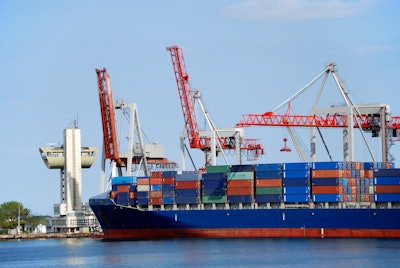
The top factors affecting global logistics right now are hedging ocean rates, environmental and geopolitical challenges, U.S. port infrastructure, railroads and technology, according to Caitlin Murphy, CEO of Global Gateway Logistics.
Murphy spoke March 13 at the American Feed Industry Association (AFIA) Purchasing and Ingredient Suppliers Conference in San Antonio.
1. Hedging ocean rates: Changing import container rates make it difficult to plan ahead. Rates, routes, carriers and availability are constantly in flux.
“For a lot of people that are in agriculture, predicting what the ocean freight rate is going to be during harvest season later this year is an extremely difficult task if you’re working on the stock market. And, vice versa, if you have ocean freight contracts, as we saw in previous years, the stock market went way below what an ocean freight contract rate was. So, being able to predict what the ocean freight rates are is becoming an extremely difficult task,” Murphy said.
2. Environmental/geopolitical: Container rates continue to be sensitive to environmental and geopolitical factors, such as drought in the Panama Canal region and conflict in the Red Sea.
“What we’re seeing is container rates continue to be really, really sensitive to anything that happens around the world, whether it’s geopolitical or environmental. … So now, what I think is happening, is the market is utilizing these events around the world to find a very strategic, acceptable spot market rate,” Murphy said.
3. U.S. port infrastructure: US$17 billion from the Bipartisan Infrastructure Bill is going toward port infrastructure. The problems of delays, lack of equipment and poor communication between the ports and rail could be fixed by ports increasing staff and space, investing in new equipment and renewed planning.
“It’s really marking the lack of transparency in communication between two massive pieces of the global supply chain. Those are the problems that we see on a day-to-day basis: the delays, the lack of equipment and the relationship with the railyard,” Murphy said.
4. Railroad: US$30 billion in infrastructure funding is going toward 70 rail improvement projects in 35 states. Delays, outdated equipment and tracking are the main problems with rail, and these can be fixed by terminals increasing staff and rethinking planning, as well as investing in terminal chassis and railcar equipment with better technology.
“If all of these different railroads are only purchasing every two or three decades, they’re missing out on some of the most emerging technology and so, just like our automobile industry, it’s going to take 100 years until all of the fleet is autonomous, right? It’s not a quick fix,” Murphy said.
5. Technology: Shippers, freight forwarders and non-vessel operating common carriers (NVOCC) should be investing in newer technologies that can enhance visibility, planning and shipment/inventory management.
“We live in a world where we’re on technology every day, why shouldn’t our location of our freight, the price of our freight, every aspect that touches a huge piece of your bottom line and your margin, why shouldn’t that data be in front of you whenever you want it, however you want it?” Murphy said.












